Polyhedral Peg, Round Hole
April 11, 2018
Pack It Up!

Image Credit: E.G. Teich, et al. The Glotzer Group at University of Michigan
What's Going On Here?
What's the best way to pack four-sided pyramids into a spherical container? How about cubes? Octahedrons?
It's not a simple question, but it's got big implications for everything from manufacturing and shipping to nanoscience. That's why scientists at the University of Michigan are studying the way things fit together, simulating different arrangements like the ones shown above to find the most efficient possible way of cramming complex shapes like dodecahedrons into a spherical volume.
The images above were generated by starting with an invisible, spherical boundary, then simulating thousands of random possible arrangements of each shape inside that container. By calculating the amount of free space inside that boundary that's not taken up by the shapes and selecting the one with the lowest unoccupied space, we can find the most efficient packing! Although these images are generated through a process that relies on randomness, the solutions we find often have many points of symmetry, making for a beautiful and complex image.














